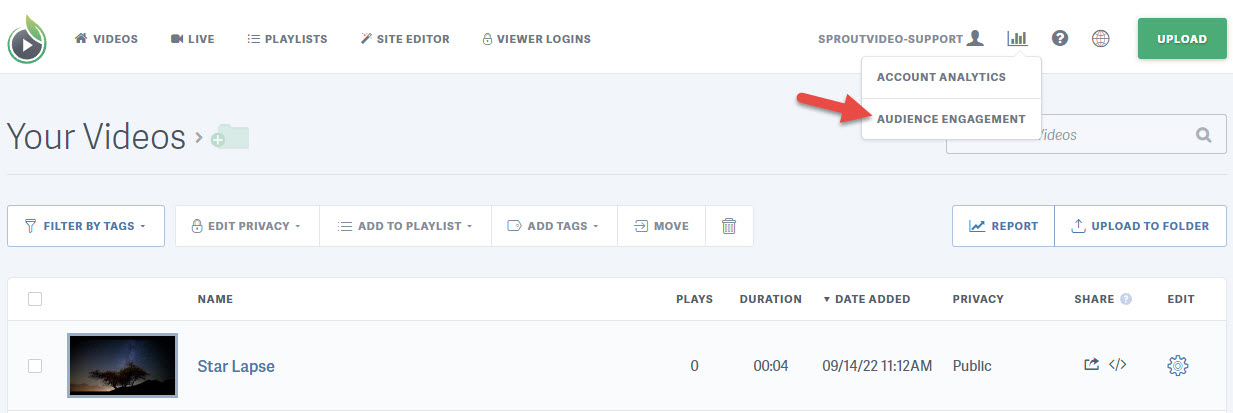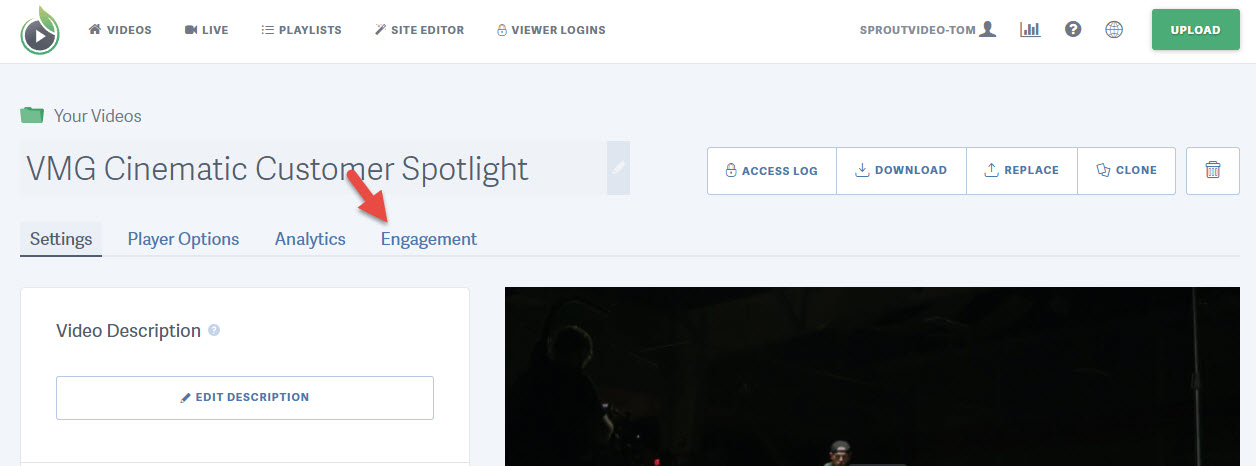Video engagement allows you to gain new insight into how your viewers are watching and interacting with your videos. We collect data on every single viewer who watches your video and present you with aggregate data for each of your videos, as well as letting you see each individual time a viewer watches your video.
Audience Engagement
You can view all of the engagement sessions that have occurred across all of your videos, in the Audience Engagement Report. To access this report, move your mouse over the bar graph icon in the top right, then click ‘Audience Engagement.’

In this report, you’ll be able to see all of the Session Data mentioned below.
Video Engagement
The Video Engagement Report will show all of the viewing sessions for a particular file. We’ll display the Aggregate Data and the individual Session Data for an individual video.
To access the Video Engagement Report navigate to a video, then select the ‘Engagement’ tab right below the title of the video.

Aggregate Data
For each video, you’ll be able to see the following information along with an engagement graph that shows what percentage of people who watched the video were still watching at a given time:
- Total Impressions - This number indicates the number of times the video was displayed (loaded) on a page.
- Unique Visitors - This number indicates the number of unique individuals who loaded the video.
- Total Plays - The number of times viewers hit the play button on the video.
- Play Rate - The percentage of Loads that resulted in plays. This number can give you a good indication of how compelling your poster frame image is or if you’re doing a good job getting people interested in watching the video.
- Total Minutes Watched - This is the total amount of time viewers spent watching your video.
- Average Engagement - The average percentage of the video that viewers watched.

Session Data
We also collect engagement data for every single time a video is watched:
- Time - The time the viewer started watching the video.
- Viewer Tag - Displays the name of the viewer if the viewer has been tagged. This name can come from either a viewer tagging or, if the viewer used a login to view the video, the email address of the login used. Clicking on this link will show you every view this user has had for all of your videos. Also, if the viewer has viewed more than one of your videos, we show you the number of other videos they have watched.
- Location - Where the viewer was located when they watched they watched the video.
- Device - Information about what device was used to watch the video.
- IP Address - The IP Address of the person who watched the video.
- URL - The URL of the page on which the video was embedded when it was viewed.

Heat Maps
Our viewer engagement heat maps make it easy to see how your viewers interacted with your videos. At a glance, you can see which parts of the videos were watched, which parts were re-watched, and which parts were skipped.
Viewer Tagging
You can tag your viewers with a nickname and email address so that you can easily keep track of them and don’t have to see “Unknown Viewer” over and over again. There are four ways to tag a viewer:
Email Collection
The first option to tag your viewers is to use the Lead Capture feature. By enabling this feature, your viewers will be required to enter their email address and optionally their first and last name before being able to view the video. This email address is used to automatically track your viewers. The viewers email address is stored in a cookie so they only have to enter their email address once to see the video even if they come back to watch the video again. To enable email collection follow our guide on how to enable Lead Capture here.
Iframe Tagging
Another way to tag a viewer is by passing along the email address with the embed code for the video. All that’s needed is the vemail query string parameter.
So, for example, if your embed code looks like this:
<iframe class='sproutvideo-player' type='text/html' src='https://videos.sproutvideo.com/embed/e898d32b5111be3c860/546cd1548x010aaeb' width='630' height='354' frameborder='0' allowfullscreen referrerpolicy='no-referrer-when-downgrade'></iframe>
and you wanted to tag the viewer with the email address test@example.com , the new embed code would look like this:
<iframe class='sproutvideo-player' type='text/html' src='https://videos.sproutvideo.com/embed/e898d32b5111be3c860/546cd1548x010aaeb?vemail=test@example.com' width='630' height='354' frameborder='0' allowfullscreen referrerpolicy='no-referrer-when-downgrade'></iframe>
URL Tagging
Viewers can also be tagged by simply adding the vemail parameter to the query string of the URL of the page on which the video is embedded.
If your video is embedded on a page with the URL https://www.example.com/my-video.html and you want to tag the viewer with the email test@example.com, send them the following URL: https://www.example.com/my-video.html?vemail=test@example.com
Manual Tagging
You can also manually tag your viewers. Click on one of the “Unknown Viewer” links on the video engagement page. From there you can click on the name or email address to change the nickname or email address for the viewer.
Note: Playback of Direct File Assets happens outside of the video player we provide so videos viewed using Direct Video File Access will not be tracked in our Analytics and Video Engagement Metrics.
Other articles in the Analytics section:



